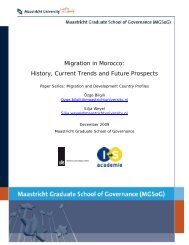Migration in Burundi: History, Current Trends and Future - MGSoG ...
Migration in Burundi: History, Current Trends and Future - MGSoG ...
Migration in Burundi: History, Current Trends and Future - MGSoG ...
Create successful ePaper yourself
Turn your PDF publications into a flip-book with our unique Google optimized e-Paper software.
(Gemeente) that an asylum seeker should stay. Those with temporary or permanent<br />
residency permits or naturalized citizens are spread across the country.<br />
<strong>Burundi</strong>ans with long-term stay permits, naturalised citizens, <strong>and</strong> highly skilled<br />
migrants are allowed to move freely <strong>in</strong> the Netherl<strong>and</strong>s with the majority concentrated <strong>in</strong><br />
major cities <strong>in</strong> the Netherl<strong>and</strong>s. 20 Most <strong>Burundi</strong>ans with long-term residency permits <strong>and</strong><br />
Dutch citizenship are well established <strong>in</strong> various cities such as The Hague, Amsterdam,<br />
Rotterdam, Utrecht, E<strong>in</strong>dhoven, Gouda, Culemborg, Lochem, <strong>and</strong> Almere. 21 Some are<br />
also found <strong>in</strong> the south of the Netherl<strong>and</strong>s <strong>in</strong> a region close to Belgium, a situation<br />
largely <strong>in</strong>fluenced by the Belgian historical connection with <strong>Burundi</strong> <strong>and</strong> the region’s<br />
proximity to Brussels, which is a major location of <strong>Burundi</strong>ans <strong>in</strong> Europe (Masc<strong>in</strong>i, et al<br />
2009) <strong>and</strong> the ma<strong>in</strong> hub for transnational l<strong>in</strong>ks <strong>and</strong> home-bound activities.<br />
There are about 20 <strong>Burundi</strong>an diaspora organizations 22 <strong>in</strong> the Netherl<strong>and</strong>s<br />
<strong>in</strong>clud<strong>in</strong>g both formal <strong>and</strong> <strong>in</strong>formal groups. The majority of these organisations 23 are<br />
registered with the chamber of commerce (KvK) 24 upon meet<strong>in</strong>g legislative requirements.<br />
This process facilitates their transformation <strong>in</strong>to formal organizations that are recognized<br />
by the public, government departments, <strong>and</strong> development agencies from which they<br />
receive fund<strong>in</strong>g for various activities. By acquir<strong>in</strong>g formal status, registered <strong>Burundi</strong>an<br />
diaspora groups are able to undertake activities <strong>in</strong> the public sphere as well as engage<br />
with other migrant groups nationwide <strong>and</strong> with EU-level diaspora platforms.<br />
In addition to formal <strong>Burundi</strong>an diaspora organisations, there are other <strong>in</strong>formal<br />
groups organised along the l<strong>in</strong>es of ethnicity, family, friends, <strong>and</strong> village of orig<strong>in</strong> <strong>in</strong><br />
<strong>Burundi</strong>. Although these <strong>in</strong>formal groups are not officially recognized <strong>and</strong> <strong>in</strong> most cases<br />
rema<strong>in</strong> anonymous, these <strong>in</strong>formal associational units also play a significant role <strong>in</strong><br />
diaspora mobilization as well as the transfer of remittances to next of k<strong>in</strong> <strong>in</strong> <strong>Burundi</strong>.<br />
Most <strong>Burundi</strong> diaspora organisations are based <strong>in</strong> the same regions or cities <strong>in</strong><br />
which their members or leadership reside. This is ma<strong>in</strong>ly for logistical reasons as well as<br />
to facilitate group activities. The formal <strong>Burundi</strong>an diaspora organisations are well<br />
organized <strong>and</strong> have clear leadership structures. While the leadership of many<br />
organisations is comprised entirely of officials of <strong>Burundi</strong>an background, some groups<br />
feature mixed leadership comprised of both <strong>Burundi</strong>ans <strong>and</strong> Dutch people. This is a<br />
feature that is common <strong>in</strong> most diaspora organisations that emphasize the necessity of<br />
20 Interview with Sticht<strong>in</strong>g Tabarana, November 25, 2009<br />
21 Interview with Sticht<strong>in</strong>g Tabarana, November 26, 2009 <strong>and</strong> <strong>Burundi</strong> <strong>in</strong> Action, October 28, 2009.<br />
22 Interview with BWPD November 26, 2009<br />
23 See appendix 1 for a list of the known <strong>Burundi</strong> organizations<br />
24 http://www.kvk.nl/english/aboutus/default.asp<br />
37



